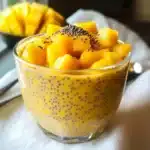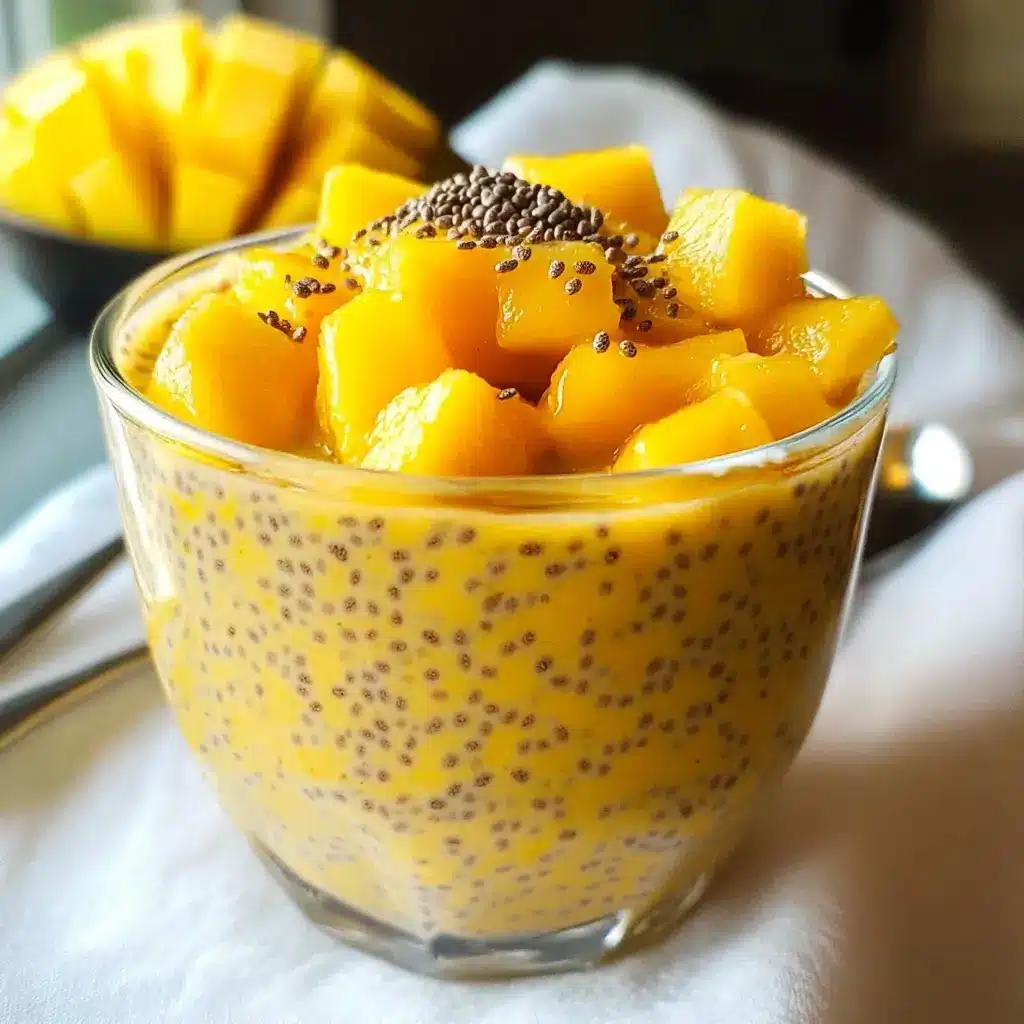Mango Chia Seed Pudding has become a delightful staple in our household, transforming our mornings and even sneaking into dessert time. Initially, I was skeptical – chia seeds for pudding? But the first spoonful was a revelation. The creamy texture, punctuated by the subtle pop of chia seeds, combined with the vibrant sweetness of mango, is simply irresistible. Even my kids, who are usually picky eaters, eagerly devour it. It’s become our go-to healthy treat, perfect for busy weekdays or a light, refreshing dessert after a heavier meal. The best part? It’s incredibly easy to make, requires minimal ingredients, and is packed with goodness. This recipe is more than just a pudding; it’s a vibrant, healthy, and utterly delicious experience.
Ingredients: The Building Blocks of Your Mango Chia Seed Pudding Masterpiece
Crafting the perfect Mango Chia Seed Pudding starts with selecting high-quality ingredients. Each component plays a vital role in the final texture, flavor, and nutritional profile of your pudding. Let’s delve into each ingredient, understanding its purpose and offering tips for choosing the best options.
- Ripe Mangoes: The Star of the Show: Mangoes are the heart and soul of this recipe, lending their tropical sweetness, vibrant color, and creamy texture. For the most flavorful pudding, opt for ripe, juicy mangoes.
- Variety Matters: While any ripe mango will work, certain varieties excel in pudding making. Alphonso mangoes, known for their rich, buttery texture and intense sweetness, are a top choice if available. Honey mangoes (also called Ataulfo) are another excellent option, offering a smooth, fiber-free flesh and a honey-like sweetness. Tommy Atkins mangoes, a common variety, are also suitable, though they might be slightly more fibrous and less intensely flavored than Alphonso or Honey mangoes. If using Tommy Atkins, ensure they are perfectly ripe to maximize sweetness and minimize fiber.
- Ripeness Test: A ripe mango will yield slightly to gentle pressure, similar to a ripe avocado or peach. It should also have a fragrant aroma emanating from the stem end. Avoid mangoes that are too firm or have bruises or blemishes. The skin color can vary depending on the variety, so rely more on touch and smell than color alone to determine ripeness.
- Fresh vs. Frozen: Fresh mangoes are undoubtedly the best for flavor and texture. However, if fresh mangoes are out of season or unavailable, frozen mango chunks can be a convenient alternative. Ensure you use unsweetened frozen mango and thaw it completely before blending for the smoothest consistency. You might need to adjust the liquid slightly if using frozen mango as they can release water upon thawing.
- Chia Seeds: The Magic Thickener and Nutritional Powerhouse: Chia seeds are the secret ingredient that transforms liquid into a luscious pudding. These tiny seeds are hydrophilic, meaning they absorb liquid and expand, creating a gel-like consistency. Beyond their thickening abilities, chia seeds are nutritional powerhouses, packed with fiber, omega-3 fatty acids, and protein.
- Types of Chia Seeds: You can use either black or white chia seeds interchangeably in this recipe. There is no significant difference in taste or gelling properties between the two. Black chia seeds are more common and readily available, while white chia seeds might offer a slightly more subtle visual appeal in lighter-colored puddings.
- Quality Matters: Opt for high-quality chia seeds that are fresh and have a good gelling capacity. Store chia seeds in an airtight container in a cool, dry place to maintain their freshness and effectiveness.
- Benefits of Chia Seeds: Incorporating chia seeds into your diet offers numerous health benefits. They are an excellent source of fiber, promoting digestive health and helping you feel full and satisfied. Their omega-3 fatty acids are beneficial for heart health and brain function. Chia seeds are also a good source of plant-based protein and antioxidants.
- Milk (Dairy or Non-Dairy): The Creamy Base: The type of milk you choose will contribute to the overall flavor and creaminess of your pudding. You have a wide range of options, catering to different dietary preferences and taste profiles.
- Dairy Milk: Whole milk will provide the richest and creamiest texture. However, 2% or skim milk can also be used for a lighter version. Dairy milk adds a subtle sweetness and richness that complements the mango flavor.
- Non-Dairy Alternatives: For a vegan or dairy-free pudding, there are numerous excellent non-dairy milk options.
- Coconut Milk (Canned, Full-Fat): Full-fat coconut milk from a can provides an incredibly rich and creamy texture, almost decadent. It imparts a subtle coconut flavor that pairs beautifully with mango. Ensure you use full-fat coconut milk for the best pudding consistency; light coconut milk will be too watery.
- Almond Milk: Unsweetened almond milk is a lighter option with a slightly nutty flavor. It works well in chia seed pudding, but the texture will be less creamy than with coconut milk or full-fat dairy milk.
- Oat Milk: Oat milk is naturally creamy and slightly sweet, making it a fantastic choice for chia seed pudding. It provides a smooth texture and a mild flavor that doesn’t overpower the mango.
- Soy Milk: Soy milk is another good option, offering a creamy texture and neutral flavor. Choose unsweetened soy milk to control the sweetness of your pudding.
- Cashew Milk: Cashew milk is known for its creamy texture and slightly sweet, nutty flavor. It’s a great non-dairy option that creates a smooth and delicious pudding.
- Sweetener (Optional): Enhancing the Natural Sweetness: Depending on the ripeness of your mangoes and your personal preference, you might want to add a touch of sweetener. Mangoes are naturally sweet, so taste your blended mango before adding any sweetener.
- Natural Sweeteners:
- Maple Syrup: Maple syrup adds a warm, caramel-like sweetness that complements mangoes beautifully. It’s a natural and unrefined sweetener option.
- Honey: Honey provides a floral sweetness and a slightly thicker consistency. If using honey, ensure it’s a mild-flavored variety so it doesn’t overpower the mango. (Note: Honey is not vegan).
- Agave Nectar: Agave nectar is a vegan sweetener with a neutral flavor and high sweetness level. Use it sparingly as it is sweeter than sugar.
- Dates (Medjool Dates): Medjool dates are a fantastic natural sweetener, adding both sweetness and fiber. Soak a few dates in hot water for about 10 minutes to soften them, then blend them into the pudding along with the mango. This adds a lovely caramel-like note and extra creaminess.
- Refined Sugar (Less Recommended): While granulated sugar, brown sugar, or powdered sugar can be used, natural sweeteners are generally preferred for their flavor complexity and nutritional benefits. If using refined sugar, start with a small amount and adjust to taste.
- Natural Sweeteners:
- Vanilla Extract (Optional, but Recommended): Enhancing Depth of Flavor: A splash of vanilla extract elevates the flavor profile of the pudding, adding warmth and complexity. Pure vanilla extract is preferred for the best flavor.
- Lime or Lemon Juice (Optional): Brightening the Flavors: A squeeze of fresh lime or lemon juice can brighten the flavors of the mango and balance the sweetness. It adds a subtle tang that enhances the overall taste.
- Pinch of Salt (Optional): Balancing Sweetness: A tiny pinch of salt (like sea salt or Himalayan pink salt) can enhance the sweetness of the mango and balance the overall flavor profile. It’s a subtle addition that makes a noticeable difference.
By carefully selecting each ingredient and understanding its role, you are well on your way to creating a truly exceptional Mango Chia Seed Pudding. The quality of your ingredients directly impacts the final taste and texture, so choosing wisely is key to pudding perfection.
Instructions: Your Step-by-Step Guide to Mango Chia Seed Pudding Perfection
Making Mango Chia Seed Pudding is remarkably simple and requires minimal active cooking time. The beauty of this recipe lies in its ease and the satisfying results it delivers. Follow these step-by-step instructions to create your own delicious and healthy mango chia seed pudding.
Step 1: Prepare the Mango
- Peel and Dice: Begin by peeling your ripe mangoes. The easiest way to peel a mango is to stand it upright and slice down each side of the pit, yielding two mango “cheeks.” Then, score the flesh of each cheek in a grid pattern, being careful not to cut through the skin. Scoop out the diced mango flesh using a spoon. Alternatively, you can peel the mango with a vegetable peeler and then dice the flesh.
- Reserve Some for Topping (Optional): If you desire a visually appealing pudding, reserve a small portion of the diced mango for topping later. Store these in the refrigerator to keep them fresh.
- Blend the Mango: Place the majority of the diced mango into a blender or food processor. Blend until completely smooth and creamy. If you are using frozen mango, ensure it is thawed slightly before blending for a smoother consistency.
Step 2: Combine Ingredients
- In a Bowl or Jar: In a medium-sized mixing bowl or individual jars (if you want to make single servings), combine the chia seeds, your chosen milk (dairy or non-dairy), and the blended mango puree.
- Add Sweetener (Optional): If you prefer a sweeter pudding, add your chosen sweetener (maple syrup, honey, agave, or dates) at this stage. Start with a small amount and taste-test, adding more to your liking. Remember that the ripeness of the mango will greatly impact the sweetness level.
- Add Vanilla and Lime/Lemon Juice (Optional): Stir in the vanilla extract and lime or lemon juice (if using). These additions enhance the flavor and create a more complex taste profile.
- Pinch of Salt (Optional): Add a tiny pinch of salt to balance the sweetness and enhance the mango flavor.
Step 3: Mix Thoroughly
- Whisk or Stir Vigorously: Use a whisk or spoon to thoroughly combine all the ingredients. Ensure the chia seeds are evenly distributed throughout the mango mixture. This step is crucial to prevent clumps of chia seeds from forming. Whisk or stir for at least a minute to ensure proper mixing.
Step 4: Chill and Set
- Cover and Refrigerate: Cover the bowl or seal the jars and refrigerate for at least 4 hours, or preferably overnight. This chilling time is essential for the chia seeds to absorb the liquid and create the pudding-like consistency.
- Stir Again (Optional): After about 30 minutes to an hour of chilling, you can stir the pudding again to break up any clumps of chia seeds that might have formed at the bottom. This will ensure a smoother final texture.
Step 5: Serve and Enjoy!
- Check Consistency: After chilling for the recommended time, check the consistency of the pudding. It should be thick and creamy. If it’s too thick, you can add a splash more milk to reach your desired consistency. If it’s too thin, you may need to add a little more chia seeds and chill for another hour or two.
- Serve Cold: Mango Chia Seed Pudding is best served cold.
- Add Toppings (Optional): Before serving, garnish your pudding with your favorite toppings, such as the reserved diced mango, fresh berries, shredded coconut, chopped nuts, granola, or a drizzle of honey or maple syrup.
Following these simple steps will reward you with a delicious, healthy, and satisfying Mango Chia Seed Pudding. The hands-on time is minimal, mostly involving blending and stirring, and the refrigerator does the rest of the work. Enjoy the process and the delightful result!
Nutrition Facts: Fueling Your Body with Goodness
Mango Chia Seed Pudding isn’t just delicious; it’s also packed with nutrients, making it a healthy choice for breakfast, snacks, or dessert. The nutritional profile will vary slightly depending on the specific ingredients used (type of milk, sweetener, toppings), but here’s a general overview based on a single serving (approximately ½ cup) made with unsweetened almond milk and no added sweetener (using a naturally sweet ripe mango).
Serving Size: Approximately ½ cup (120-150g)
Estimated Nutritional Information Per Serving:
- Calories: 180-250 calories (depending on mango ripeness and milk type)
- Protein: 5-7 grams
- Fat: 8-12 grams
- Saturated Fat: 1-3 grams (primarily from coconut milk if used)
- Monounsaturated Fat: 1-2 grams
- Polyunsaturated Fat (Omega-3 Fatty Acids): 4-6 grams (primarily from chia seeds)
- Carbohydrates: 25-35 grams
- Fiber: 10-12 grams
- Sugar: 15-20 grams (naturally occurring from mango)
- Sodium: 20-50 mg (depending on milk type)
- Potassium: 250-350 mg (from mango)
- Vitamin C: 50-70% of Daily Value (from mango)
- Vitamin A: 10-15% of Daily Value (from mango)
- Calcium: 10-20% of Daily Value (depending on milk type; higher in dairy and fortified non-dairy milks)
- Iron: 4-6% of Daily Value
- Magnesium: 8-12% of Daily Value
- Omega-3 Fatty Acids: A significant source of ALA (alpha-linolenic acid) omega-3s.
Key Nutritional Benefits:
- High in Fiber: Chia seeds are an excellent source of dietary fiber. Fiber is essential for digestive health, promoting regularity, and helping to maintain healthy cholesterol levels. It also contributes to feelings of fullness, which can aid in weight management.
- Rich in Omega-3 Fatty Acids: Chia seeds are one of the best plant-based sources of omega-3 fatty acids, particularly ALA. Omega-3s are important for heart health, brain function, and reducing inflammation in the body.
- Good Source of Protein: Chia seeds provide a decent amount of plant-based protein, contributing to satiety and muscle building and repair.
- Antioxidant Powerhouse: Mangoes are rich in antioxidants, including Vitamin C and Vitamin A, as well as other phytonutrients. Antioxidants help protect your cells from damage caused by free radicals, contributing to overall health and disease prevention.
- Vitamins and Minerals: Mangoes are a good source of Vitamin C, Vitamin A, and potassium, among other vitamins and minerals. These nutrients are crucial for various bodily functions, including immune health, vision, and blood pressure regulation.
- Sustained Energy: The combination of fiber, protein, and healthy fats in Mango Chia Seed Pudding provides sustained energy release, preventing blood sugar spikes and crashes, making it an excellent choice for breakfast or a healthy snack.
- Naturally Gluten-Free and Vegan: This recipe is naturally gluten-free and vegan (if using non-dairy milk and vegan sweetener like maple syrup or agave), making it suitable for a wide range of dietary needs and preferences.
Important Note: These nutritional values are estimates and can vary. For more precise information, you can use online nutritional calculators and input the specific brands and quantities of ingredients you use. Always consult with a registered dietitian or nutritionist for personalized dietary advice.
Incorporating Mango Chia Seed Pudding into your diet is a delicious and nutritious way to boost your intake of fiber, omega-3s, vitamins, and antioxidants. It’s a guilt-free treat that nourishes your body from the inside out.
Preparation Time: Quick and Easy, Perfect for Busy Days
One of the greatest advantages of Mango Chia Seed Pudding is its minimal preparation time. This recipe is ideal for busy individuals or anyone looking for a healthy and delicious meal or snack without spending hours in the kitchen.
- Active Prep Time: Approximately 10-15 minutes. This includes:
- Peeling and dicing the mango (5-7 minutes)
- Blending the mango (2-3 minutes)
- Measuring and combining the remaining ingredients (3-5 minutes)
- Stirring to combine (1-2 minutes)
- Inactive Time (Chilling Time): Minimum 4 hours, ideally overnight. This is the time required for the chia seeds to absorb the liquid and transform the mixture into pudding.
- Total Time (Prep + Chill): 4 hours and 15 minutes minimum (or overnight). However, most of this time is hands-off chilling time.
Time-Saving Tips:
- Prepare in Advance: Mango Chia Seed Pudding is perfect for meal prepping. You can make a large batch on the weekend and have healthy breakfasts or snacks ready to go for the entire week. It keeps well in the refrigerator for up to 5 days.
- Use Frozen Mango: If you’re short on time or fresh mangoes are not readily available, using frozen mango chunks can save you peeling and dicing time. Just ensure they are thawed slightly before blending.
- Single Serving Jars: Prepare individual servings directly in jars. This eliminates the need to transfer the pudding later and makes for easy grab-and-go breakfasts or snacks.
- Overnight Chilling: Prepare the pudding in the evening and let it chill overnight. This allows the flavors to meld together beautifully and ensures the pudding is perfectly set by morning.
Mango Chia Seed Pudding truly embodies the concept of “set it and forget it” cooking. With just a few minutes of active prep time, you can create a healthy and satisfying meal or snack that is ready whenever you are. Its ease of preparation makes it a perfect choice for busy mornings, quick desserts, or healthy meal prep.
How to Serve: Creative and Delicious Ways to Enjoy Your Mango Chia Seed Pudding
Mango Chia Seed Pudding is incredibly versatile and can be enjoyed in countless ways. From simple breakfasts to elegant desserts, here are some creative serving suggestions to elevate your pudding experience:
- Classic Breakfast Bowl:
- Fresh Fruit: Top with a medley of fresh berries like strawberries, blueberries, raspberries, or sliced bananas. The tartness of berries complements the sweetness of mango beautifully.
- Granola: Sprinkle your favorite granola for added crunch and texture. Choose a healthy granola with nuts, seeds, and oats for extra fiber and nutrients.
- Nuts and Seeds: Add chopped almonds, walnuts, pecans, or a sprinkle of pumpkin seeds or sunflower seeds for healthy fats and protein.
- Shredded Coconut: Toasted or unsweetened shredded coconut adds a tropical touch and enhances the coconut flavor if you used coconut milk.
- Drizzle of Honey or Maple Syrup: If you prefer a sweeter breakfast, drizzle a touch of honey or maple syrup over the toppings.
- Dessert Delight:
- Whipped Cream or Coconut Whipped Cream: Top with a dollop of light whipped cream or vegan coconut whipped cream for a more decadent dessert.
- Chocolate Shavings or Cacao Nibs: Dark chocolate shavings or cacao nibs add a touch of bitterness that balances the sweetness of the mango and provides antioxidant benefits.
- Caramel Sauce or Date Caramel: A drizzle of caramel sauce or a homemade date caramel adds richness and sweetness.
- Mint Sprig: Garnish with a fresh mint sprig for a refreshing and elegant touch.
- Layered Dessert Parfait: Layer Mango Chia Seed Pudding with layers of granola, fresh fruit, and yogurt (dairy or non-dairy) in a glass for a visually appealing and delicious dessert parfait.
- Snack Attack:
- Plain and Simple: Enjoy it straight from the jar for a quick and healthy snack. It’s satisfying on its own!
- Fruit Compote: Top with a warm fruit compote (like berry compote or apple compote) for a cozy and comforting snack.
- Nut Butter Swirl: Swirl in a spoonful of your favorite nut butter (peanut butter, almond butter, cashew butter) for added protein and healthy fats.
- Spiced Pudding: Sprinkle with a pinch of cinnamon, nutmeg, or cardamom for a warm and spiced flavor variation.
- Tropical Twist:
- Passion Fruit Pulp: Top with fresh passion fruit pulp for an extra burst of tropical flavor and tangy sweetness.
- Toasted Macadamia Nuts: Add toasted macadamia nuts for a rich and buttery crunch that complements the mango and tropical theme.
- Lime Zest: Grate lime zest over the top for a bright and zesty finish.
- Pineapple Chunks: Add small chunks of fresh or grilled pineapple for a tropical fruit medley.
- Presentation Ideas:
- Individual Jars: Serve in small mason jars or glass containers for individual portions, perfect for meal prep or elegant presentation.
- Wine Glasses: For a dessert presentation, serve in wine glasses or martini glasses for a sophisticated touch.
- Bowls: Serve in beautiful bowls to showcase the vibrant colors of the pudding and toppings.
- Garnish Creatively: Get creative with your garnishes! Arrange toppings artfully for a visually appealing and Instagram-worthy pudding.
No matter how you choose to serve it, Mango Chia Seed Pudding is a delightful and versatile treat. Experiment with different toppings and presentations to find your favorite ways to enjoy this healthy and delicious pudding.
Additional Tips for Mango Chia Seed Pudding Perfection
While Mango Chia Seed Pudding is incredibly easy to make, these additional tips can help you elevate your recipe and ensure consistently delicious results every time:
- Adjust Sweetness to Your Liking: Mangoes vary in sweetness depending on ripeness and variety. Always taste your blended mango puree before adding any sweetener. If your mangoes are very ripe and sweet, you might not need any added sweetener at all. Start with a small amount of sweetener and add more gradually until you reach your desired sweetness level. Remember, you can always add more sweetener, but you can’t take it away!
- Control the Consistency: The ratio of chia seeds to liquid is crucial for achieving the perfect pudding consistency. This recipe provides a general guideline, but you can adjust it based on your preference.
- For a Thicker Pudding: If you prefer a thicker pudding, add an extra tablespoon or two of chia seeds.
- For a Thinner Pudding: If you prefer a thinner, more drinkable pudding, use slightly less chia seeds or add a splash more milk before chilling.
- Stirring is Key: Ensure you stir the chia seeds into the liquid very thoroughly at the beginning. This prevents clumping and ensures even gelling. Stir again after about 30 minutes of chilling to break up any potential clumps.
- Enhance Mango Flavor: To intensify the mango flavor, consider using mango puree instead of just blended mango. Mango puree is often more concentrated in flavor. You can also add a tiny drop of mango extract (use sparingly as it can be potent). Using high-quality, ripe mangoes is the most important factor in maximizing mango flavor.
- Experiment with Spices and Extracts: While vanilla extract is a classic addition, don’t be afraid to experiment with other flavor enhancers.
- Cardamom: A pinch of ground cardamom adds a warm, exotic spice note that pairs beautifully with mango.
- Cinnamon: Cinnamon provides a comforting and familiar spice flavor.
- Ginger: A tiny bit of grated fresh ginger or ground ginger adds a subtle warmth and zing.
- Almond Extract: A few drops of almond extract can add a nutty and slightly sweet aroma.
- Coconut Extract: If you love coconut flavor, a touch of coconut extract can enhance the coconut milk base.
- Make it Creamier: For an extra creamy and decadent pudding, consider adding one of these options:
- Full-Fat Coconut Milk: Using full-fat coconut milk as the base liquid will naturally result in a richer and creamier pudding.
- Cashew Cream: Blend soaked cashews with a little water to create a cashew cream and add a tablespoon or two to your pudding mixture.
- Avocado: A small amount of avocado (about ¼ of a ripe avocado per serving) blended into the mango mixture will add incredible creaminess without altering the flavor significantly.
By incorporating these tips, you can customize your Mango Chia Seed Pudding to your exact preferences and consistently create a delicious and satisfying treat. Don’t be afraid to experiment and find your perfect pudding recipe!
FAQ: Your Burning Questions About Mango Chia Seed Pudding Answered
Here are some frequently asked questions about Mango Chia Seed Pudding to help you troubleshoot and further understand this delightful recipe:
Q1: Can I make Mango Chia Seed Pudding ahead of time?
A: Absolutely! In fact, Mango Chia Seed Pudding is an ideal make-ahead recipe. It needs to chill for at least 4 hours to set properly, and it actually tastes even better after the flavors have had time to meld together overnight. You can prepare a batch on the weekend and enjoy it throughout the week for breakfasts, snacks, or desserts. Store it in airtight containers in the refrigerator for up to 5 days. This make-ahead convenience is one of the biggest appeals of chia seed pudding, making it perfect for busy lifestyles and meal prepping. Knowing you have a healthy and delicious breakfast or snack ready in the fridge can be a real time-saver and a boost to healthy eating habits.
Q2: My chia seed pudding is too runny, what did I do wrong?
A: If your chia seed pudding is too runny, there are a few potential reasons and easy fixes:
- Not Enough Chia Seeds: The most common reason is not using enough chia seeds relative to the liquid. Ensure you are using the correct ratio of chia seeds to liquid as specified in the recipe. If you used less chia seeds, you can try adding another tablespoon or two of chia seeds to the mixture, stir well, and refrigerate for another 1-2 hours to allow them to thicken further.
- Insufficient Chilling Time: Chia seeds need time to absorb liquid and gel. Make sure you have chilled the pudding for at least 4 hours, preferably overnight. If you haven’t chilled it long enough, simply return it to the refrigerator for a longer chilling period.
- Type of Milk: Using a very watery milk alternative (like some very diluted almond milks) might result in a slightly thinner pudding. If you are using a watery milk, you might need to slightly increase the amount of chia seeds. Full-fat coconut milk or oat milk generally produce thicker puddings.
- Mango Consistency: If your blended mango was very watery (perhaps from using frozen mango that released a lot of water upon thawing), this could also contribute to a thinner pudding. In this case, you might need to add a little more chia seeds to compensate.
Q3: My chia seed pudding is too thick, how can I thin it out?
A: If your chia seed pudding is too thick for your liking, it’s very easy to adjust the consistency:
- Add More Liquid: Simply add a tablespoon or two of your chosen milk (dairy or non-dairy) at a time, stirring well after each addition, until you reach your desired consistency. You can use the same type of milk you used to make the pudding initially.
- Water or Juice (Optional): In a pinch, you can also add a tablespoon of water or mango juice to thin it out. However, adding milk will generally maintain the creaminess and flavor better.
Q4: Can I use other fruits besides mango in chia seed pudding?
A: Absolutely! Mango Chia Seed Pudding is just one delicious variation. Chia seed pudding is incredibly versatile and works well with a wide variety of fruits. Feel free to experiment with other fruit purees or combinations:
- Berry Chia Seed Pudding: Use blended berries like strawberries, blueberries, raspberries, or mixed berries.
- Banana Chia Seed Pudding: Blend ripe bananas for a naturally sweet and creamy pudding.
- Peach or Nectarine Chia Seed Pudding: Use blended peaches or nectarines for a summery flavor.
- Pineapple Chia Seed Pudding: Blend pineapple chunks for a tropical twist.
- Apple Cinnamon Chia Seed Pudding: Use applesauce or blended cooked apples with cinnamon and a touch of maple syrup for a fall-inspired pudding.
- Chocolate Chia Seed Pudding: Add cocoa powder and a sweetener to create a chocolate chia seed pudding base.
You can also combine fruits, such as mango and passion fruit, or berries and banana, to create your own unique flavor combinations. The possibilities are endless!
Q5: Is Mango Chia Seed Pudding suitable for weight loss?
A: Yes, Mango Chia Seed Pudding can be a great addition to a weight loss or weight management plan. Here’s why:
- High in Fiber: Chia seeds are packed with fiber, which helps you feel full and satisfied for longer, reducing overall calorie intake. Fiber also aids in digestion and blood sugar control.
- Good Source of Protein: Chia seeds provide a decent amount of plant-based protein, which also contributes to satiety and helps maintain muscle mass during weight loss.
- Healthy Fats: Chia seeds are rich in healthy fats, particularly omega-3 fatty acids. These fats are beneficial for overall health and can also contribute to feelings of fullness.
- Nutrient-Dense: Mango Chia Seed Pudding is packed with vitamins, minerals, and antioxidants, providing essential nutrients while being relatively low in calories (especially if you use unsweetened milk and minimal sweetener).
- Control Portions: Chia seed pudding is naturally portion-controlled. A serving size of ½ cup is often satisfying due to the fiber and protein content.
However, it’s important to be mindful of added sweeteners and toppings if you are watching your calorie intake. Opt for natural sweeteners in moderation and choose healthy toppings like fresh fruit, nuts, and seeds. Mango Chia Seed Pudding, when made with healthy ingredients and consumed in moderation, can be a nutritious and satisfying part of a balanced weight loss diet.
We hope these FAQs have addressed your questions about Mango Chia Seed Pudding! Enjoy experimenting with this versatile and healthy recipe and making it your own.
Print
Mango Chia Seed Pudding
Ingredients
Crafting the perfect Mango Chia Seed Pudding starts with selecting high-quality ingredients. Each component plays a vital role in the final texture, flavor, and nutritional profile of your pudding. Let’s delve into each ingredient, understanding its purpose and offering tips for choosing the best options.
- Ripe Mangoes: The Star of the Show: Mangoes are the heart and soul of this recipe, lending their tropical sweetness, vibrant color, and creamy texture. For the most flavorful pudding, opt for ripe, juicy mangoes.
- Variety Matters: While any ripe mango will work, certain varieties excel in pudding making. Alphonso mangoes, known for their rich, buttery texture and intense sweetness, are a top choice if available. Honey mangoes (also called Ataulfo) are another excellent option, offering a smooth, fiber-free flesh and a honey-like sweetness. Tommy Atkins mangoes, a common variety, are also suitable, though they might be slightly more fibrous and less intensely flavored than Alphonso or Honey mangoes. If using Tommy Atkins, ensure they are perfectly ripe to maximize sweetness and minimize fiber.
- Ripeness Test: A ripe mango will yield slightly to gentle pressure, similar to a ripe avocado or peach. It should also have a fragrant aroma emanating from the stem end. Avoid mangoes that are too firm or have bruises or blemishes. The skin color can vary depending on the variety, so rely more on touch and smell than color alone to determine ripeness.
- Fresh vs. Frozen: Fresh mangoes are undoubtedly the best for flavor and texture. However, if fresh mangoes are out of season or unavailable, frozen mango chunks can be a convenient alternative. Ensure you use unsweetened frozen mango and thaw it completely before blending for the smoothest consistency. You might need to adjust the liquid slightly if using frozen mango as they can release water upon thawing.
- Chia Seeds: The Magic Thickener and Nutritional Powerhouse: Chia seeds are the secret ingredient that transforms liquid into a luscious pudding. These tiny seeds are hydrophilic, meaning they absorb liquid and expand, creating a gel-like consistency. Beyond their thickening abilities, chia seeds are nutritional powerhouses, packed with fiber, omega-3 fatty acids, and protein.
- Types of Chia Seeds: You can use either black or white chia seeds interchangeably in this recipe. There is no significant difference in taste or gelling properties between the two. Black chia seeds are more common and readily available, while white chia seeds might offer a slightly more subtle visual appeal in lighter-colored puddings.
- Quality Matters: Opt for high-quality chia seeds that are fresh and have a good gelling capacity. Store chia seeds in an airtight container in a cool, dry place to maintain their freshness and effectiveness.
- Benefits of Chia Seeds: Incorporating chia seeds into your diet offers numerous health benefits. They are an excellent source of fiber, promoting digestive health and helping you feel full and satisfied. Their omega-3 fatty acids are beneficial for heart health and brain function. Chia seeds are also a good source of plant-based protein and antioxidants.
- Milk (Dairy or Non-Dairy): The Creamy Base: The type of milk you choose will contribute to the overall flavor and creaminess of your pudding. You have a wide range of options, catering to different dietary preferences and taste profiles.
- Dairy Milk: Whole milk will provide the richest and creamiest texture. However, 2% or skim milk can also be used for a lighter version. Dairy milk adds a subtle sweetness and richness that complements the mango flavor.
- Non-Dairy Alternatives: For a vegan or dairy-free pudding, there are numerous excellent non-dairy milk options.
- Coconut Milk (Canned, Full-Fat): Full-fat coconut milk from a can provides an incredibly rich and creamy texture, almost decadent. It imparts a subtle coconut flavor that pairs beautifully with mango. Ensure you use full-fat coconut milk for the best pudding consistency; light coconut milk will be too watery.
- Almond Milk: Unsweetened almond milk is a lighter option with a slightly nutty flavor. It works well in chia seed pudding, but the texture will be less creamy than with coconut milk or full-fat dairy milk.
- Oat Milk: Oat milk is naturally creamy and slightly sweet, making it a fantastic choice for chia seed pudding. It provides a smooth texture and a mild flavor that doesn’t overpower the mango.
- Soy Milk: Soy milk is another good option, offering a creamy texture and neutral flavor. Choose unsweetened soy milk to control the sweetness of your pudding.
- Cashew Milk: Cashew milk is known for its creamy texture and slightly sweet, nutty flavor. It’s a great non-dairy option that creates a smooth and delicious pudding.
- Sweetener (Optional): Enhancing the Natural Sweetness: Depending on the ripeness of your mangoes and your personal preference, you might want to add a touch of sweetener. Mangoes are naturally sweet, so taste your blended mango before adding any sweetener.
- Natural Sweeteners:
- Maple Syrup: Maple syrup adds a warm, caramel-like sweetness that complements mangoes beautifully. It’s a natural and unrefined sweetener option.
- Honey: Honey provides a floral sweetness and a slightly thicker consistency. If using honey, ensure it’s a mild-flavored variety so it doesn’t overpower the mango. (Note: Honey is not vegan).
- Agave Nectar: Agave nectar is a vegan sweetener with a neutral flavor and high sweetness level. Use it sparingly as it is sweeter than sugar.
- Dates (Medjool Dates): Medjool dates are a fantastic natural sweetener, adding both sweetness and fiber. Soak a few dates in hot water for about 10 minutes to soften them, then blend them into the pudding along with the mango. This adds a lovely caramel-like note and extra creaminess.
- Refined Sugar (Less Recommended): While granulated sugar, brown sugar, or powdered sugar can be used, natural sweeteners are generally preferred for their flavor complexity and nutritional benefits. If using refined sugar, start with a small amount and adjust to taste.
- Natural Sweeteners:
- Vanilla Extract (Optional, but Recommended): Enhancing Depth of Flavor: A splash of vanilla extract elevates the flavor profile of the pudding, adding warmth and complexity. Pure vanilla extract is preferred for the best flavor.
- Lime or Lemon Juice (Optional): Brightening the Flavors: A squeeze of fresh lime or lemon juice can brighten the flavors of the mango and balance the sweetness. It adds a subtle tang that enhances the overall taste.
- Pinch of Salt (Optional): Balancing Sweetness: A tiny pinch of salt (like sea salt or Himalayan pink salt) can enhance the sweetness of the mango and balance the overall flavor profile. It’s a subtle addition that makes a noticeable difference.
By carefully selecting each ingredient and understanding its role, you are well on your way to creating a truly exceptional Mango Chia Seed Pudding. The quality of your ingredients directly impacts the final taste and texture, so choosing wisely is key to pudding perfection.
Instructions
Making Mango Chia Seed Pudding is remarkably simple and requires minimal active cooking time. The beauty of this recipe lies in its ease and the satisfying results it delivers. Follow these step-by-step instructions to create your own delicious and healthy mango chia seed pudding.
Step 1: Prepare the Mango
- Peel and Dice: Begin by peeling your ripe mangoes. The easiest way to peel a mango is to stand it upright and slice down each side of the pit, yielding two mango “cheeks.” Then, score the flesh of each cheek in a grid pattern, being careful not to cut through the skin. Scoop out the diced mango flesh using a spoon. Alternatively, you can peel the mango with a vegetable peeler and then dice the flesh.
- Reserve Some for Topping (Optional): If you desire a visually appealing pudding, reserve a small portion of the diced mango for topping later. Store these in the refrigerator to keep them fresh.
- Blend the Mango: Place the majority of the diced mango into a blender or food processor. Blend until completely smooth and creamy. If you are using frozen mango, ensure it is thawed slightly before blending for a smoother consistency.
Step 2: Combine Ingredients
- In a Bowl or Jar: In a medium-sized mixing bowl or individual jars (if you want to make single servings), combine the chia seeds, your chosen milk (dairy or non-dairy), and the blended mango puree.
- Add Sweetener (Optional): If you prefer a sweeter pudding, add your chosen sweetener (maple syrup, honey, agave, or dates) at this stage. Start with a small amount and taste-test, adding more to your liking. Remember that the ripeness of the mango will greatly impact the sweetness level.
- Add Vanilla and Lime/Lemon Juice (Optional): Stir in the vanilla extract and lime or lemon juice (if using). These additions enhance the flavor and create a more complex taste profile.
- Pinch of Salt (Optional): Add a tiny pinch of salt to balance the sweetness and enhance the mango flavor.
Step 3: Mix Thoroughly
- Whisk or Stir Vigorously: Use a whisk or spoon to thoroughly combine all the ingredients. Ensure the chia seeds are evenly distributed throughout the mango mixture. This step is crucial to prevent clumps of chia seeds from forming. Whisk or stir for at least a minute to ensure proper mixing.
Step 4: Chill and Set
- Cover and Refrigerate: Cover the bowl or seal the jars and refrigerate for at least 4 hours, or preferably overnight. This chilling time is essential for the chia seeds to absorb the liquid and create the pudding-like consistency.
- Stir Again (Optional): After about 30 minutes to an hour of chilling, you can stir the pudding again to break up any clumps of chia seeds that might have formed at the bottom. This will ensure a smoother final texture.
Step 5: Serve and Enjoy!
- Check Consistency: After chilling for the recommended time, check the consistency of the pudding. It should be thick and creamy. If it’s too thick, you can add a splash more milk to reach your desired consistency. If it’s too thin, you may need to add a little more chia seeds and chill for another hour or two.
- Serve Cold: Mango Chia Seed Pudding is best served cold.
- Add Toppings (Optional): Before serving, garnish your pudding with your favorite toppings, such as the reserved diced mango, fresh berries, shredded coconut, chopped nuts, granola, or a drizzle of honey or maple syrup.
Following these simple steps will reward you with a delicious, healthy, and satisfying Mango Chia Seed Pudding. The hands-on time is minimal, mostly involving blending and stirring, and the refrigerator does the rest of the work. Enjoy the process and the delightful result!
Nutrition
- Serving Size: one normal portion
- Calories: 250
- Sugar: 20
- Fat: 12
- Carbohydrates: 35
- Protein: 7






